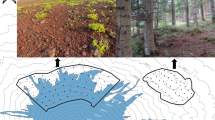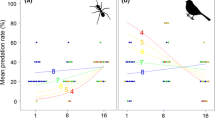Abstract
Ávila-Pires’ saddle-back tamarins (Saguinus fuscicollis avilapiresi) and red-cap moustached tamarins (S. mystax pileatus), coexisting in highly stable mixed-species groups, overlapped considerably in their use of plant food resources at an Amazonian terra firme forest site. Overlap between food types consumed by the two species was particularly high during periods of lowest fruit availability, when they resorted to a common food supply, primarily the pod exudates of two emergent species of legume trees (Parkia nitida andParkia pendula) and nectar ofSymphonia globulifera. Within-group interspecific competition did not covary with independent measures of resource availability, contrary to predictions based on resource partitioning models. A greater number of both saddle-back and moustached tamarins were able to feed for longer patch residence periods within larger and more productive food patches, whereas small and clumped patches could be monopolized by the socially and numerically dominant moustached tamarins to the physical exclusion of the smaller-bodied saddle-back tamarins. Overall rates of interspecific aggression were extremely low, however, partly because patches that could be monopolized contributed with a minor proportion of either species’ diet. Saddle-backs foraged at lower levels in the understory and encountered smaller food patches more often, whereas moustached tamarins foraged higher and encountered more larger patches in the middle canopy. Although the two species led one another to differently-sized patches, moustached tamarins initiated most feeding bouts and encountered significantly larger and more productive patches that tended to accommodate the entire mixed-species group. Disadvantages of exploitative and interference feeding competition over plant resources, and advantages of shared knowledge of food patches, are but one component of the overall cost-benefit relationship of interspecific associations in tamarins.
Similar content being viewed by others
References
Bradbury, J. W., and Vehrencamp, S. L. (1977). Social organization and foraging in emballonurid bats. I. Field studies.Behav. Ecol Sociobiol. 1: 337–381.
Castro, N. R. (1991).Behavioral Ecology of Two Coexisting Tamarin Species (Saguinus fuscicollis nigrifronsand Saguinus mystax mystax,Callitrichidae, Primates) in Amazonian Peru, Unpublished. Ph.D. thesis, Washington University, Saint Louis.
Chapman, C. (1988). Patch use and patch depletion by the spider and howling monkeys of Santa Rosa National Park, Costa Rica.Behaviour 105: 97–116.
Chapman, C. A., Wrangham, R. W., and Chapman, L. J. (1995). Ecological constraint on group size: An analysis of spider monkey and chimpanzee subgroups.Behav. Ecol. Sociobiol. 36: 59–70.
Clutton-Brock, T. H., and Harvey, P. H. (1977). Primate ecology and social organization.J. Zool. Lond.: 183: 1–39.
Coelho, A. M., Coelho, L. S., Bramblett, C. A., Bramblett, S. S., and Quick L. B. (1976). Ecology, population characteristics, and sympatric association in primates: A sociobioenergetic analysis of howler and spider monkeys at Tikal, Guatemala.Yb. Phys. Anthropol. 20: 95–135.
Cords, M. (1987) Mixed-species association ofCercopithecus monkeys in the Kakamega Forest, Kenya.Univ. Calif. Publ. Zool. 117: 1–109.
Cottam, G., and Curtis, J. T. (1956). The use of distance measurements in phytosociological sampling.Ecology 37: 451–460.
Eisenberg, J. F., Muckenhirn, N., and Rudran, R. (1972). The relationship between ecology and social structure in primates.Science 176: 863–874.
Garber, P. A. (1986). The ecology of seed dispersal in two species of callitrichid primates (Saguinus mystax andSaguinus fuscicollis).Am. J. Primatol. 10: 155–177.
Garber, P. A. (1988). Diet, foraging patterns, and resource defense in a mixed species troop ofSaguinus mystax andSaguinus fuscicollis in Amazonian Peru.Behaviour 105: 18–34.
Gautier-Hion, A. (1978). Food-niches and coexistence in sympatric primates in Gabon. In Olivers, D. J., and Herbert, J. (eds.),Recent Advances in Primatology, Vol. 1, Academic Press, New York.
Gentry, A. H., and Emmons, L. H. (1987). Geographical variation in fertility, phenology, and composition of the understory of Neotropical forests.Biotropica 19: 216–227.
Heymann, E. W. (1990). Interspecific relations in a mixed-species troop of moustached tamarins,Saguinus mystax, and saddle-back tamarins (Platyrrhini: Callitrichidae), at the Río Blanco, Peruvian Amazonia.Am. J. Primatol. 21: 115–127.
Horn, H. (1968). The adaptive significance of colonial nesting in the brewers blackbird (Euphagus cynocephalus).Ecology 49: 682–694.
Hubrecht, R. C. (1985). Home-range and use and territorial behavior in the common marmoset,Caltithrix jacchus jacchus, at Tapacura Field Station, Recife, Brazil.Int. J. Primatol 6: 533–550.
Izawa, K. (1978). A field study of the ecology and behavior of the black-mantle tamarin (Saguinus nigricollis).Primates 19: 241–274.
Janson, C. H. (1985). Aggressive competition and individual food consumption in the brown capuchin monkey (Cebus apella).Behav. Ecol. Sociobiol. 18: 125–138.
Janson, C. H. (1988). Food competition in brown capuchin monkeys (Cebus apella): Quantitative effects of group size and tree productivity.Behaviour 105: 53–76.
Leighton, M., and Leighton, D. R. (1982). The relationship of size of feeding aggregate to size of food patch: Howler monkeys (Alouatta palliata) feeding inTrichilia cipo fruit trees on Barro Colorado Island.Biotropica 14: 81–90.
Linton, L. R., Davies, R. W., and Wrona, F. J. (1981). Resource utilization indices: an assessment.J. Anim. Ecol. 50: 283–292.
Manly, B. F. J. (1990). On the statistical analysis of niche overlap data.Can. J. Zool. 68: 1420–1422.
Menzel, E. W., Jr., and Juno, C. (1985). Social foraging in marmoset monkeys and the question of intelligence.Phil. Trans. R. Soc. Lond. 308: 145–158.
Mitchell, C. L., Boinski, S., and Schaik, C. P. (1991). Competitive regimes and female bonding in two species of squirrel monkeys (Saimiri oerstedi andS. sciureus).Behav. Ecol. Sociobiol. 28: 55–60.
Monge, T. G. F. (1987).Importancia de los Frutos en la Dieta de Saguinus mystax y S. fuscicollis (Primates, Callitrichidae) en el R’o Tahuayo, Loreto—PerÚ, M.Sc. thesis, Universidad Nacional de la Amazon’a Peruana, Iquitos.
Natori, M., and Hanihara, T. (1992). Intrageneric variations of the dental measurements in the genusSaguinus and its systematic relationships.Folia Primatol. 58: 84–92.
Norconk, M. A. (1990). Mechanisms promoting stability in mixedSaguinus mystax and 5.fuscicollis troops.Am. J. Primatol. 21: 159–170.
Park, T. (1954). Experimental studies of interspecific competition in two species ofTribolium.Physiol. Zool. 27: 177–238.
Peres, C. A. (1989). Costs and benefits of territorial defense in golden lion tamarins (Leontopithecus rosalia).Behav. Ecol. Sociobiol. 25: 227–233.
Peres, C. A. (1991).Ecology of Mixed-Species Groups of Tamarins in Amazonian Terra Firme Forests, Ph.D. thesis, University of Cambridge, Cambridge.
Peres, C. A. (1992a). Prey-capture benefits in a mixed-species group of Amazonian tamarins,Saguinus fuscicollis and 5.mystax.Behav. Ecol. Sociobiol. 31: 339–347.
Peres, C. A. (1992b). Consequences of joint-territoriality in a mixed-species group of tamarin monkeys.Behaviour 123: 220–246.
Peres, C. A. (1993a). Structure and spatial organization of an Amazonian terra firme forest primate community.J. Trop. Ecol. 9: 259–276.
Peres, C. A. (1993b). Diet and feeding ecology of saddle-back (Saguinus fuscicollis) and moustached (S. mystax) tamarins in an Amazonian terra firme forest.J. Zool. Lond. 230: 567–592.
Peres, C. A. (1994a). Primate responses to phenological changes in an Amazonian terra firme forest.Biotropica 26(3): 285–294.
Peres, C. A. (1994b). Antipredation benefits in a mixed-species group of Amazonian tamarins.Folia Primatol. 61: 97–103
Peres, C. A. (1994c). Plant resource use and partitioning in two tamarin species and woolly monkeys in an Amazonian terra firme forest. In Thierry, B., Anderson, J. R., Roeder, J. J., and Herrenschmidt, N. (eds.),Current Primatology, Vol. I: Ecology and Evolution, Université Louis Pasteur, Strasbourg, France, pp. 57–66.
Peres, C. A. (1996). Use of space, foraging group size, and spatial group structure in gray woolly monkeys (Lagothrix lagotricha cana): A review of the Atelinae. In Norconk, M., Rosenberger, A., and Garber, P. (eds.),Adaptive Radiations of Neotropical Primates Plenum, New York (in press).
Petraitis, P. S. (1979). Likelihood measures of niche breadth and overlap.Ecology 60: 703–710.
Pook, A. G., and Pook, G. (1982). Polyspecific association betweenSaguinus fuscicollis, Saguinus labiatus, Callimico goeldii and other primates in North-Western Bolivia.Folia Primatol. 38: 196–216.
Pyke, G. H., Pulliam, H. R., and Charnov, E. L. (1977). Optimal foraging: a selective review of theory and tests.Q. Rev. Biol. 52: 137–154.
Schaik, C. P., and Hoff, J. (1983). On the ultimate causes of primate social systems.Behaviour 85: 91–117.
Schaik, C. P., and Noordwijk, M. A. (1988). Scramble and contest in feeding competition among female long-tailed macaques (Macaca fascicularis).Behaviour 105: 77–98.
Schluter, D. (1981). Does the theory of optimal diets apply in complex environments?Am. Nat. 118: 139–147.
Schoener, T. W. (1968). TheAnolis lizards of Bimini: resource partitioning in a complex fauna.Ecobgy 49: 704–726.
Schoener, T. W. (1974). Temporal resource partitioning and the compression hypothesis.Proc. Natl. Acad, Sci. 71: 4169–4172
Schoener, T. W. (1982). The controversy over interspecific competition.Am. Sci. 70: 586–595
Smith, J. N. M., Grant, P. R., Grant, B. R., Abbott, I. J., and Abbott, L. K. (1978). Seasonal variation in feeding habits of Darwin’s ground finches.Ecology 59: 1137–1150
Snowdon, C. T., and Soini, P. (1988). The tamarins, genusSaguinus. In Mittermeier, R. A., Rylands, A. B., Coimbra-Filho, A. B., and Fonseca, G. A. B. (eds.),Ecology and Behavior of Neotropical Primates, Vol. 2, World Wildlife Fund, Washington, DC, pp. 223–298
Soini, P. (1987). Ecology of the saddle-back tamarinsSaguinus fuscicollis illigeri on the Rio Pacaya, northeastern Peru.Folia Primatol. 49: 11–32.
Sokal, R. R., and Rohlf, F. J. (1981).Biometry, 2nd ed., Freeman, San Francisco.
Symington, M. M. (1988). Food competition and foraging party size in the black spider monkey (Ateles paniscus chamek).Behaviour 105: 117–134
Terborgh, J. (1983).Five New World Primates: A Study in Comparative Ecology. Princeton University Press, Princeton, NJ.
Terborgh, J. (1990). Mixed-species flocks and polyspecific associations: Costs and benefits of mixed groups to birds and monkeys.Am. J. Primatol. 21: 87–100.
Terborgh, J., and Janson, C. (1986). The socioecology of primate groups.Annu. Rev. Ecol. Syst. 17: 111–135.
Ward, P., and Zahavi, A. (1973). The importance of certain assemblages of birds as “information centers” for food finding. 115: 517–534.
Waser, P. M. (1987). Interactions among primate species. In Smuts, B. B., Cheney, D. L., Seyfarth, R. M., Wrangham, R. W., and Struhsaker, T. T. (eds.),Primate Societies, University of Chicago Press, Chicago, pp. 210–226.
White, F. J., and Wrangham, R. W. (1988). Feeding competition and patch size in the chimpanzee speciesPan paniscus andPan troglodytes.Behaviour 105: 148–164.
Willis, E. O. (1966). Competitive exclusion and birds at fruiting trees in western Colombia.Auk 83: 479–480.
Yoneda, M. (1984). Comparative studies on vertical separation, foraging behavior and traveling of saddle-backed tamarins (Saguinus fuscicollis) and red-chested moustached tamarins (Saguinus labiatus) in northern Bolivia.Primates 25: 414–422.
Author information
Authors and Affiliations
Rights and permissions
About this article
Cite this article
Peres, C.A. Food patch structure and plant resource partitioning in interspecific associations of amazonian tamarins. Int J Primatol 17, 695–723 (1996). https://doi.org/10.1007/BF02735261
Received:
Accepted:
Issue Date:
DOI: https://doi.org/10.1007/BF02735261




